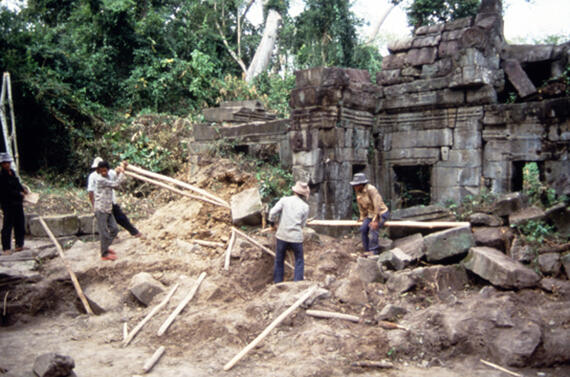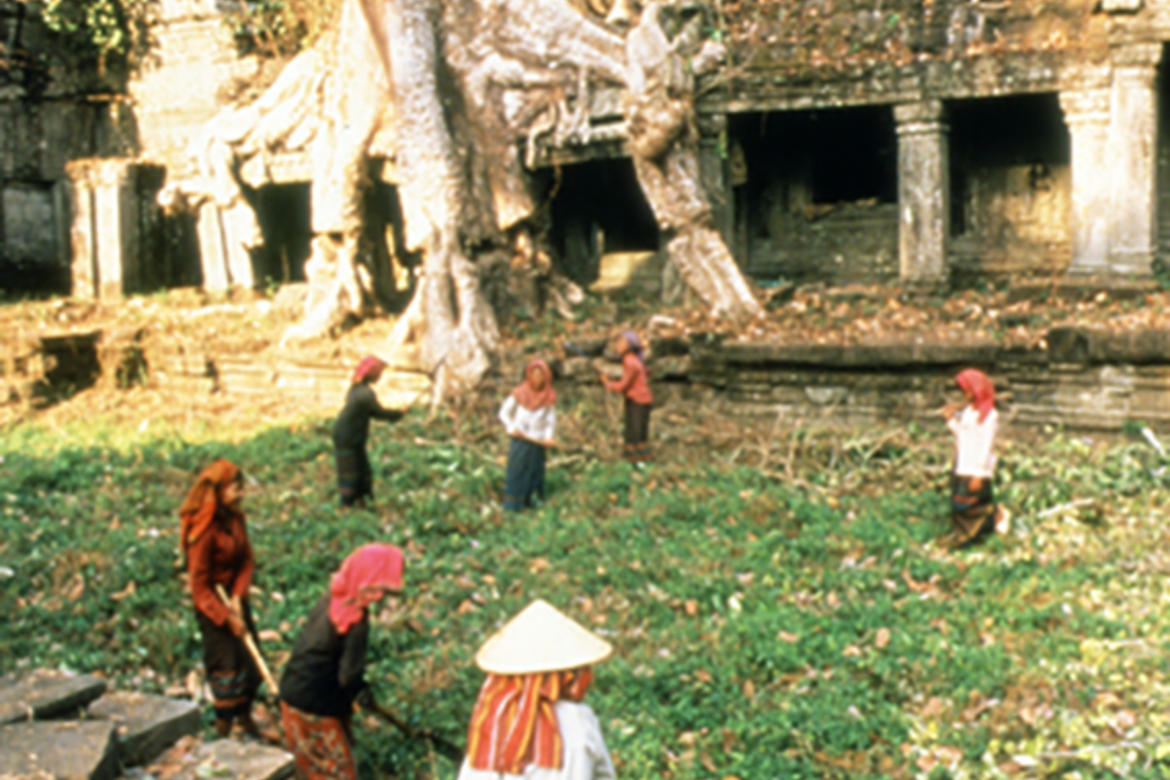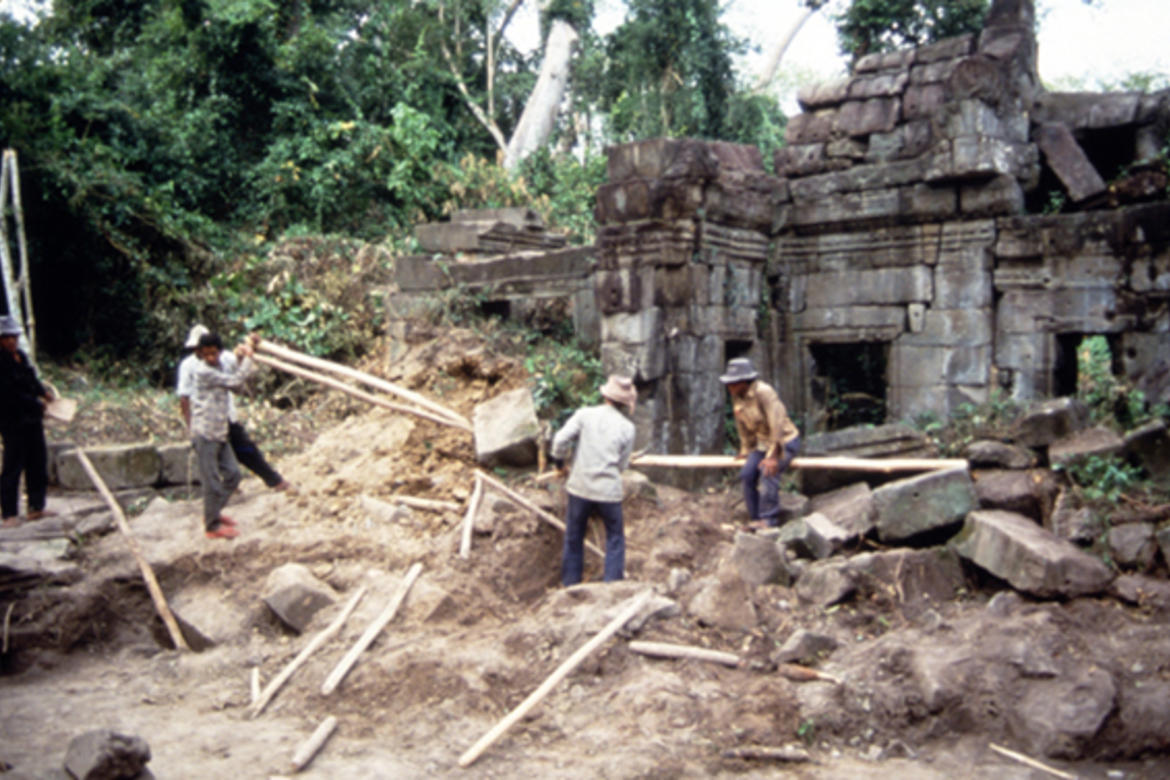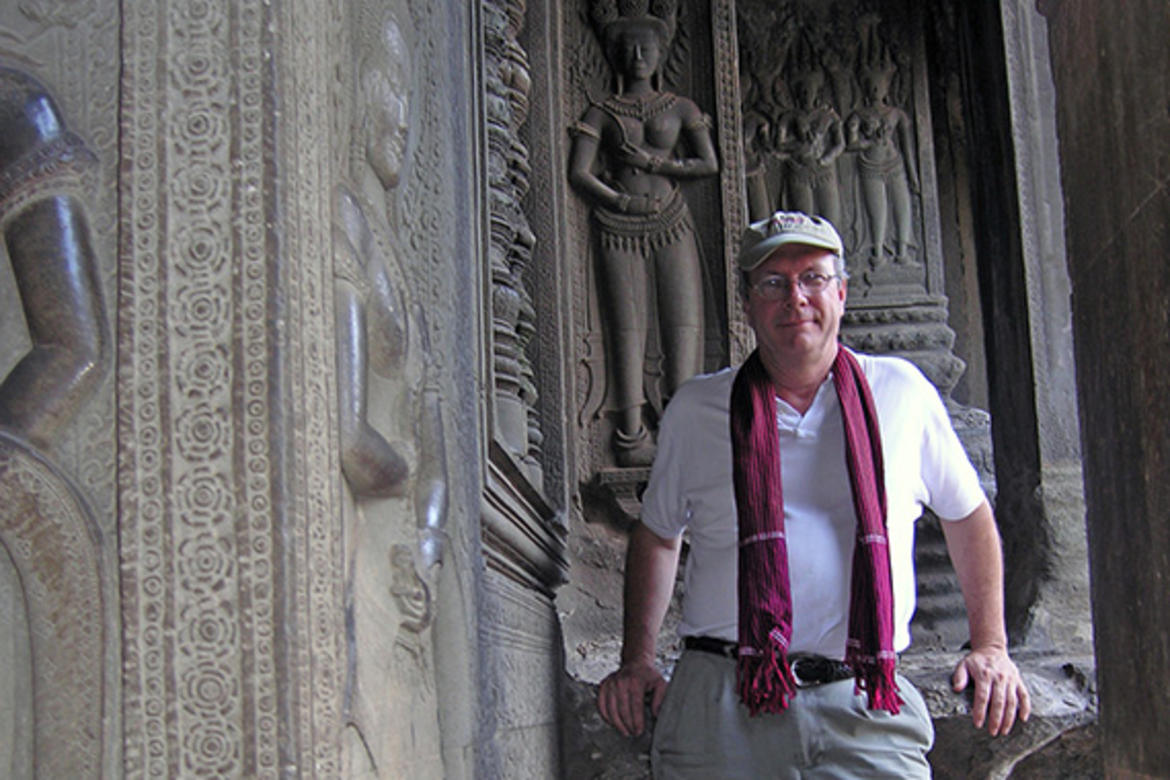Angkor: A Life-Changing Experience

The Beginning of an Adventure
Little did I know how being sent on my first trip to Cambodia by World Monuments Fund in April of 1991 would change my life.
As WMF’s Program Director, my assignment was to observe the start of conservation planning work that had just begun at the twelfth-century Khmer temple complex of Preah Khan, a key monument within the immense Angkor Archaeological Park. British architect and project manager John Sandy had selected the site after a reconnaissance tour of Angkor in 1989. This was his third mission and was well underway with various pilot conservation projects.
It was my first trip to Asia and I remember arriving in the afternoon in scorching hot Phnom Penh and making my way to Monoram Hotel in the heart of the war-ravaged capital. The city was half empty, its streets were lined with debris, and there was a distinct military presence. The poverty, lack of hygiene, and eerie quietness of the place was astonishing.
On day two, after a discussion at breakfast about loud gunfire heard during the night, our small delegation of architectural conservationists visited the directors of the barely functioning Ministry of Culture, the National Museum, and the Royal University of Fine Arts. Our plan of action for the third WMF mission to Cambodia was agreed upon in a letter of agreement called a kret.
On the next day our one-hour flight north to Siem Reap, where Angkor is located, was another edgy experience. The tires of the aged Russian Tupelov airliner were literally threadbare and clouds of humidified air billowed from flapping ceiling panels as we took off. From above, the country seemed completely undeveloped.
Upon our arrival we moved into a rented, raised wooden house on Wat Bo Road that was rustic but clean. Our cheerful house staff consisting of Son, Hari, and Sarun made us feel at home. We were living in the heart of a local village within the sleepy provincial seat of Siem Reap province that seemed to operate at a standstill. While there was a flurry of United Nations peacekeeping activity throughout Cambodia at the time, the annual number of tourists numbered no more than a few thousand adventurers.
Exploring Angkor
Finally, we drove six kilometers east to the archaeological park for an introduction to Angkor. I was stunned by the unbelievable size and majesty of iconic Angkor Wat temple—the largest religious building in the world. From there we journeyed to nearby Angkor Thom, with stops to climb the Bayon and view the Terrace of the Elephants. Having not been tended to by the French-managed Conservation d’Angkor since the early 1970s, all temples at Angkor, other than Angkor Wat, were covered in young tree growth and jungle.
Our destination of Preah Khan at the remote north edge of the ancient city still lay ahead, and my journey reminded me of the movie Apocalypse Now. On finally arriving at Preah Khan’s west entrance, its size and appearance seemed unimpressive. It was almost completely overgrown and birds were calling loudly from amidst the site’s forest of very tall beautiful trees. Avoiding areas with signs saying “Danger - Mines!,” we traversed Preah Khan’s longitudinal axis as far as possible via gopuras (gateways), shrines, tower structures, connecting halls, and courtyards. It was then that the enormity of the site revealed itself!
For the next two days I was speechless. Stunningly beautiful, romantic, and pristine as Preah Khan was, I asked myself: How could we ever make sense of this immense half-buried huge complex and do meaningful conservation work here? What had we gotten ourselves into?
The Work Begins
My dismay slowly gave way to working with John Sanday, engineer Predrag Gavrilovic, and archaeologist Fred Aldsworth, determining the physical extent of the site and its principal conservation priorities. Sanday had engaged about 120 day-workers who were busy clearing two decades of jungle growth under the direction of our chef d’chantier named Ouk Samon. Aldsworth had chosen a collapsed sandstone and laterite shrine in the West Vishnu complex as a pilot documentation and reconstruction exercise. Six archaeology and architecture students from the Royal University of the Arts measured and drew the same area.
Due to the heat, our days on site started at 7 am and ended at 3 pm. At the ring of a gong heard throughout the site, the whole work effort broke for lunch at noon. Jungle clearance workers added to their meals creatures encountered that morning including: snakes, bats, rats, and grub worms. I recall their taking discovered medicinal plants back to their villages at the end of the day on their bicycles.
After days of removing vegetation, the architecture of the large monastic complex began to come to light. As noted from earlier French reports, the 96-hectare site was encircled by four tall enclosure walls and a perimeter moat. Prior to our arrival, Preah Khan had been abandoned for over 400 years, though it was a pilgrimage spot for a few locals. We discovered a barely accessible candle lit votive at the central sanctum sanctorum shrine that was maintained by an aged local villager—a nun—whose handsome lined face and betel nut-stained warm smile lasts in my memory.
After working hard for ten days with the team to revise the preliminary master plan for conserving the site, I departed for New York via Bangkok, the only air transfer point into Cambodia at the time. Within a week I gave a slide show to the board of trustees and senior staff of WMF, barely containing my enthusiasm for one of the most exciting architectural experiences imaginable. I reassured them that our work in Cambodia was viable and was probably sustainable, which proved true since it has benefitted from the organization’s support for going on 27 years now.
Reflecting on a Life-Changing Experience
For my part, it was an honor to participate in and represent the amazing field projects of WMF for the next two decades until 2011. As the organization expanded, especially after our introduction of the World Monuments Watch program in 1996, I attended to numerous other projects and programs in the region, Europe, and elsewhere. It is from those experiences, with a sense of both duty and gratitude, I set about documenting best practices in architectural conservation in different parts of the world. The third book in my Time Honored Architectural Conservation Documentation series entitled Architectural Conservation in Asia: National Experiences and Practice (Routledge) was just released in November.
I think that, on every one of my over three dozen missions and tours given in Cambodia on behalf of World Monuments Fund, someone said: “The experience of Angkor changed my life.” For certain, I can say the same.



